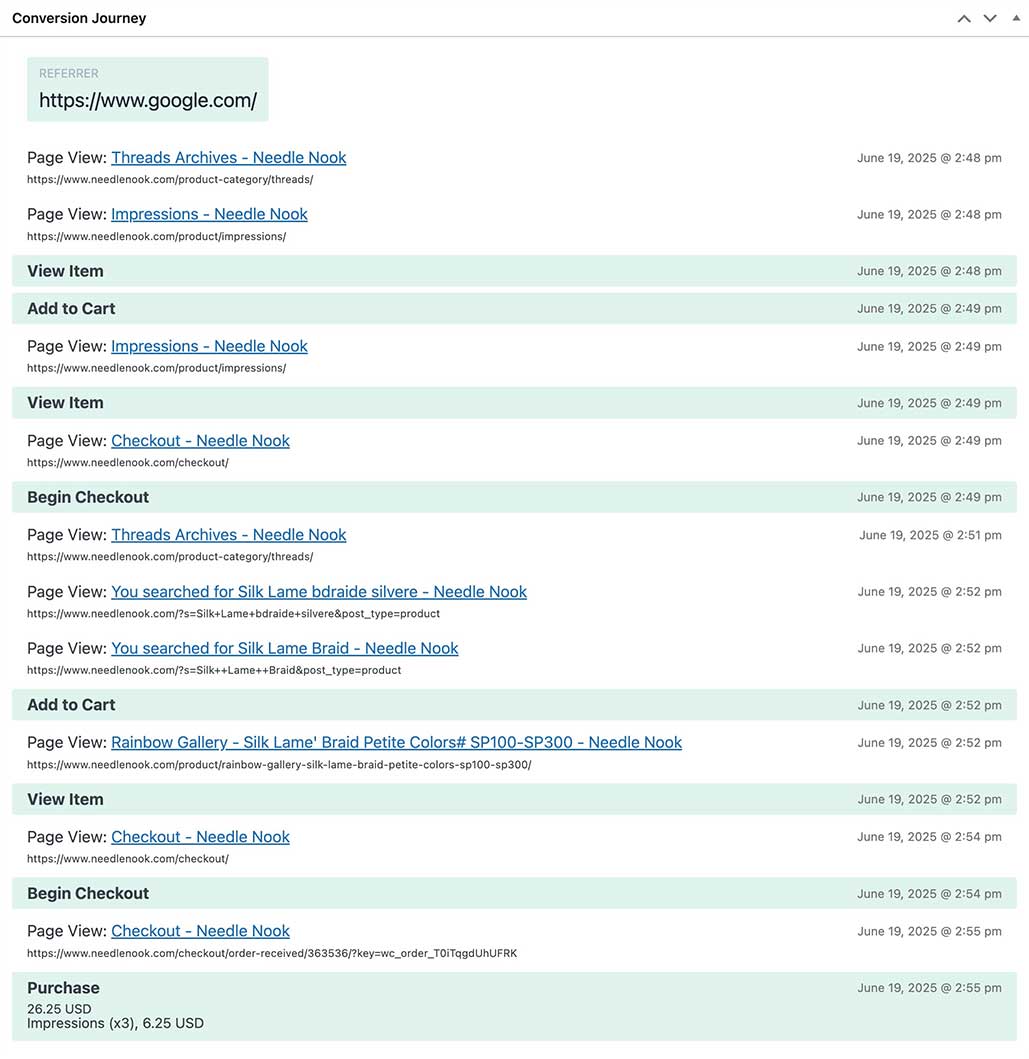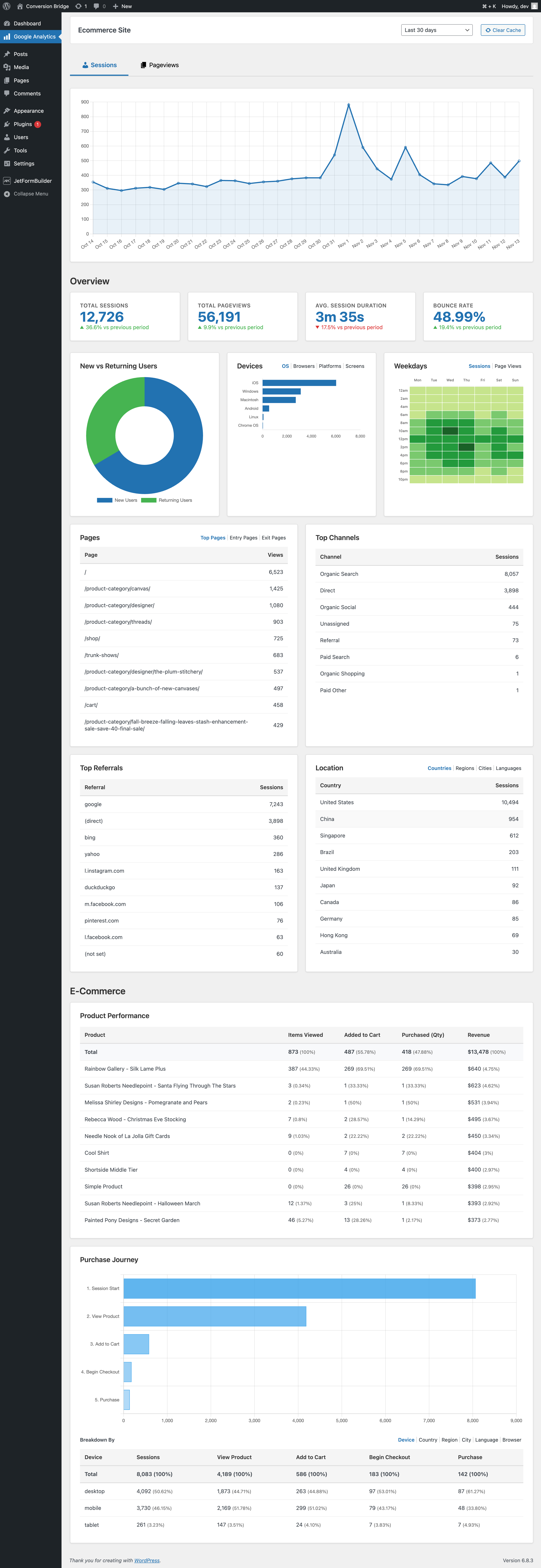The best wordpress plugin for Google Analytics
Go beyond a basic setup—Conversion Bridge makes it easy to add Google Analytics to your site with advanced conversion tracking from 61 plugins


Comprehensive Google Analytics WordPress Plugin with No-Code Conversion Tracking
Conversion Bridge makes Google Analytics setup simple and helps you go beyond basic page view data to get you detailed insights about your website visitors
-
Advanced Tag Setup
Pasting the basic tracking tag isn’t enough. Conversion Bridge unlocks full Google Analytics power with an advanced, no-code setup.
-
Ecommerce Tracking
Track every last detail about the items that were purchased in to Google Analytics to give you comprehensive performance data of your store.
-
Google Consent Mode
Ensure your Google Analytics setup obeys consent and adjusts tracking based on each visitor’s choices.
-
Analytics in Admin
Actually understand what Google Analytics is collecting with our custom GA4 dashboard in your WordPress admin.
-
Custom User Data
Include extra pageview attributes like: Author, Category, Tags, Post Type, Role, Language, Logged In status, current membership, and more for additional insights.
-
Measurement Protocol
Send server-side events to Google Analytics without touching any code. This makes your tracking more reliable by filling in gaps from ad blockers or browser limits.
-
Custom Event Tracking
Use custom events to handle any unique case on your site and keep your tracking flexible and complete.
-
Privacy Friendly
Works with your site's cookie popup to follow privacy rules, with support for it's own cookie-free data tracking where you have control over how users are tracked.
What Conversions You Can Track in Google Analytics
If you want to grow your website, tracking conversions in Google Analytics is key. It shows what's working, what's not, and how users interact with your content.
Conversion Bridge makes it simple to track important events from any of the 61 plugin integrations and your own custom events into Google Analytics so you have the data to understand what is working for your site.
-
E-Commerce Events
Sends complete product data with conversion events
- Purchases
- Donations
- View Item
- Add to Cart
- Remove from Cart
- View Cart
- Begin Checkout
-
Form events
Better than automatic form tracking, ensure you get accurate tracking & collect form submission values
- Form Submissions
- Submission Values
- Registrations
- Email List Subscribes
-
Other Events
- Button Clicks
- File Downloads
- Enrollments
- Scroll
- Time on Page
- Phone Links
- Search Results
- Video Plays
- Image Clicks
- Popups Opened/Closed
- Custom JavaScript Events
Google Analytics Dashboard in WordPress Admin
Make it easy for you or your clients to see the important data from Google Analytics right in the WordPress admin
Conversion Journeys Tell A Story
See exactly what your customers did before and after converting—page by page. Understand behavior, improve funnels, and uncover what really drives results.

More than a WordPress Google Analytics plugin
With 1647 integration combinations, Conversion Bridge is like Zapier for conversion tracking. It's the only WordPress analytics plugin you need in your stack to track the conversion events that actually matter.
- Purchases
- Form Submissions
- Button Clicks
- Donations
- Signups
- File Downloads
...and many more events
From Frustrated to Enlightened
See how real WordPress users are finding it easier than ever using Conversion Bridge to gain clarity, cut wasted ad spend, and make smarter decisions from their analytics to grow their business.
Marketing Without Conversion Tracking Is Guesswork
Conversion Bridge makes it easy to set up analytics and track important conversion events on your WordPress website—no code, no headaches, done in minutes—so you have the right data to make informed decisions
WordPress Conversion Tracking for Google Analytics
- Conversion tracking for WooCommerce in Google Analytics
- Conversion tracking for Easy Digital Downloads in Google Analytics
- Conversion tracking for WS Form in Google Analytics
- Conversion tracking for LifterLMS in Google Analytics
- Conversion tracking for Fluent Forms in Google Analytics
- Conversion tracking for Gravity Forms in Google Analytics
- Conversion tracking for Formidable Forms in Google Analytics
- Conversion tracking for WP Forms in Google Analytics
- Conversion tracking for Ninja Forms in Google Analytics
- Conversion tracking for Forminator in Google Analytics
- Conversion tracking for Contact Form 7 in Google Analytics
- Conversion tracking for Happy Forms in Google Analytics
- Conversion tracking for Everest Forms in Google Analytics
- Conversion tracking for Calculated Fields Form in Google Analytics
- Conversion tracking for Quill Forms in Google Analytics
- Conversion tracking for Form Maker by 10web in Google Analytics
- Conversion tracking for JetFormBuilder in Google Analytics
- Conversion tracking for Kali Forms in Google Analytics
- Conversion tracking for LearnDash in Google Analytics
- Conversion tracking for Sensei in Google Analytics
- Conversion tracking for Charitable in Google Analytics
- Conversion tracking for BookingPress in Google Analytics
- Conversion tracking for LatePoint in Google Analytics
- Conversion tracking for Simply Schedule Appointments in Google Analytics
- Conversion tracking for Groundhogg in Google Analytics
- Conversion tracking for FluentCRM in Google Analytics
- Conversion tracking for Mailster in Google Analytics
- Conversion tracking for The Newsletter Plugin in Google Analytics
- Conversion tracking for MailPoet in Google Analytics
- Conversion tracking for Mailchimp for WordPress in Google Analytics
- Conversion tracking for weForms in Google Analytics
- Conversion tracking for Popup Builder in Google Analytics
- Conversion tracking for Holler Box in Google Analytics
- Conversion tracking for Thrive Leads in Google Analytics
- Conversion tracking for IceGram in Google Analytics
- Conversion tracking for WP Subscribe Pro in Google Analytics
- Conversion tracking for Restrict Content Pro in Google Analytics
- Conversion tracking for Paid Memberships Pro in Google Analytics
- Conversion tracking for MemberMouse in Google Analytics
- Conversion tracking for MemberPress in Google Analytics
- Conversion tracking for UltimateMember in Google Analytics
- Conversion tracking for Simple Membership in Google Analytics
- Conversion tracking for SureMembers in Google Analytics
- Conversion tracking for SureCart in Google Analytics
- Conversion tracking for Ultimate Membership Pro in Google Analytics
- Conversion tracking for BuddyBoss in Google Analytics
- Conversion tracking for Profile Builder Pro in Google Analytics
- Conversion tracking for Paid Member Subscriptions in Google Analytics
- Conversion tracking for Sunshine Photo Cart in Google Analytics
- Conversion tracking for WP Simple Pay in Google Analytics
- Conversion tracking for ProfilePress in Google Analytics
- Conversion tracking for WP User Frontend in Google Analytics
- Conversion tracking for GiveWP in Google Analytics
- Conversion tracking for Download Monitor in Google Analytics
- Conversion tracking for Tutor LMS in Google Analytics
- Conversion tracking for SliceWP in Google Analytics
- Conversion tracking for Kadence in Google Analytics
- Conversion tracking for ClickWhale in Google Analytics
- Conversion tracking for WordPress Blocks in Google Analytics
- Conversion tracking for AffiliateWP in Google Analytics
- Conversion tracking for Solid Affiliate in Google Analytics
- Conversion tracking for Leaky Paywall in Google Analytics
- Conversion tracking for Bricks Builder in Google Analytics
- Conversion tracking for Document Library Pro in Google Analytics
- Conversion tracking for Beaver Builder in Google Analytics
- Conversion tracking for Elementor in Google Analytics
- Conversion tracking for Divi 4 in Google Analytics
- Conversion tracking for SureForms in Google Analytics
- Conversion tracking for Bricksforge Pro Forms in Google Analytics
- Conversion tracking for Popup Maker in Google Analytics
- Conversion tracking for Hustle by wpmudev in Google Analytics
- Conversion tracking for Greyd Suite in Google Analytics
- Conversion tracking for Breakdance in Google Analytics
- Conversion tracking for Paymattic in Google Analytics
- Conversion tracking for FluentCart in Google Analytics









































